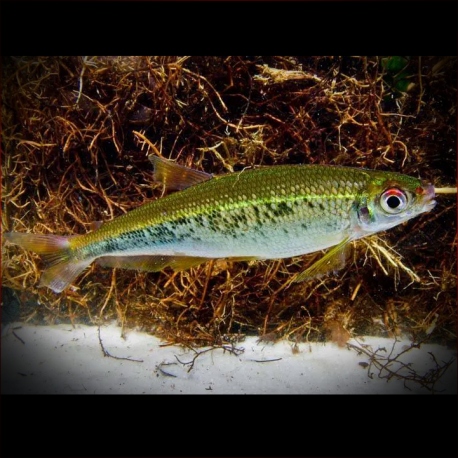More info
Datasheet
| Maximum Size | 10.3cm / 4.06inches |
General Description
Iguanodectes variatus is a species belonging to the relatively small genus Iguanodectes within the family Iguanodectidae. Characterized by an elongate body, basally-contracted multicuspid teeth, and a unique swim bladder structure, this species showcases distinct features common to its genus, such as an expansion of the first proximal anal-fin pterygiophore and a thinner anterior portion of the posterior swim bladder chamber.
Aquarium Setup
When setting up an aquarium for I. variatus, it is essential to provide a well-maintained tank with appropriate water parameters. A tank size of at least 20 gallons for a small group is recommended. Ensure a temperature range of 72-79°F (22-26°C), a pH of 5.5-7.5, and soft to moderately hard water (see table). Incorporate live plants and driftwood to mimic its natural habitat, and use subdued lighting to create a comfortable environment.
Behaviour
Iguanodectes variatus is known to exhibit peaceful behavior, making it suitable for community tanks. These tetras prefer swimming in schools, and their social nature is emphasized when kept with conspecifics or other non-aggressive fish species. They are active swimmers, often seen exploring various levels of the aquarium, and tend to be more active during dawn and dusk.
Feeding and Diet
In the wild, I. variatus primarily feeds on small invertebrates and zooplankton. In a home aquarium, they readily accept high-quality flake food, live or frozen brine shrimp, daphnia, and micro worms. Supplement their diet with vegetable matter such as blanched spinach or spirulina flakes to ensure nutritional balance. Offer small, frequent feedings to accommodate their small size and fast metabolism.
Reproduction & Dimorphism
The reproductive habits of I. variatus in captivity mirror their behavior in the wild. They are egg-scatterers, with females depositing adhesive eggs among plants or substrate. Males typically display more intense coloration during courtship. Sexual dimorphism is subtle, with females often being slightly larger and displaying rounder bellies when carrying eggs. Provide ample plant cover for egg scattering and consider a separate breeding tank for successful breeding.
Habitat and Distribution
Native to the Amazon river basin in Brazil, I. variatus has been found in various river systems, including the Guaporé, Madeira, Branco, Trombetas, and Urubu. The species inhabits shallow, slow-moving waters rich in vegetation, where they can forage for food and seek shelter. As a part of the Iguanodectidae family, I. variatus thrives in the intricately structured aquatic ecosystems typical of its natural habitat.

